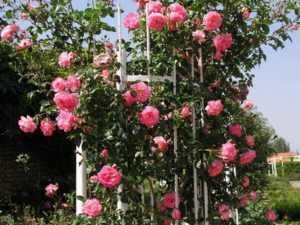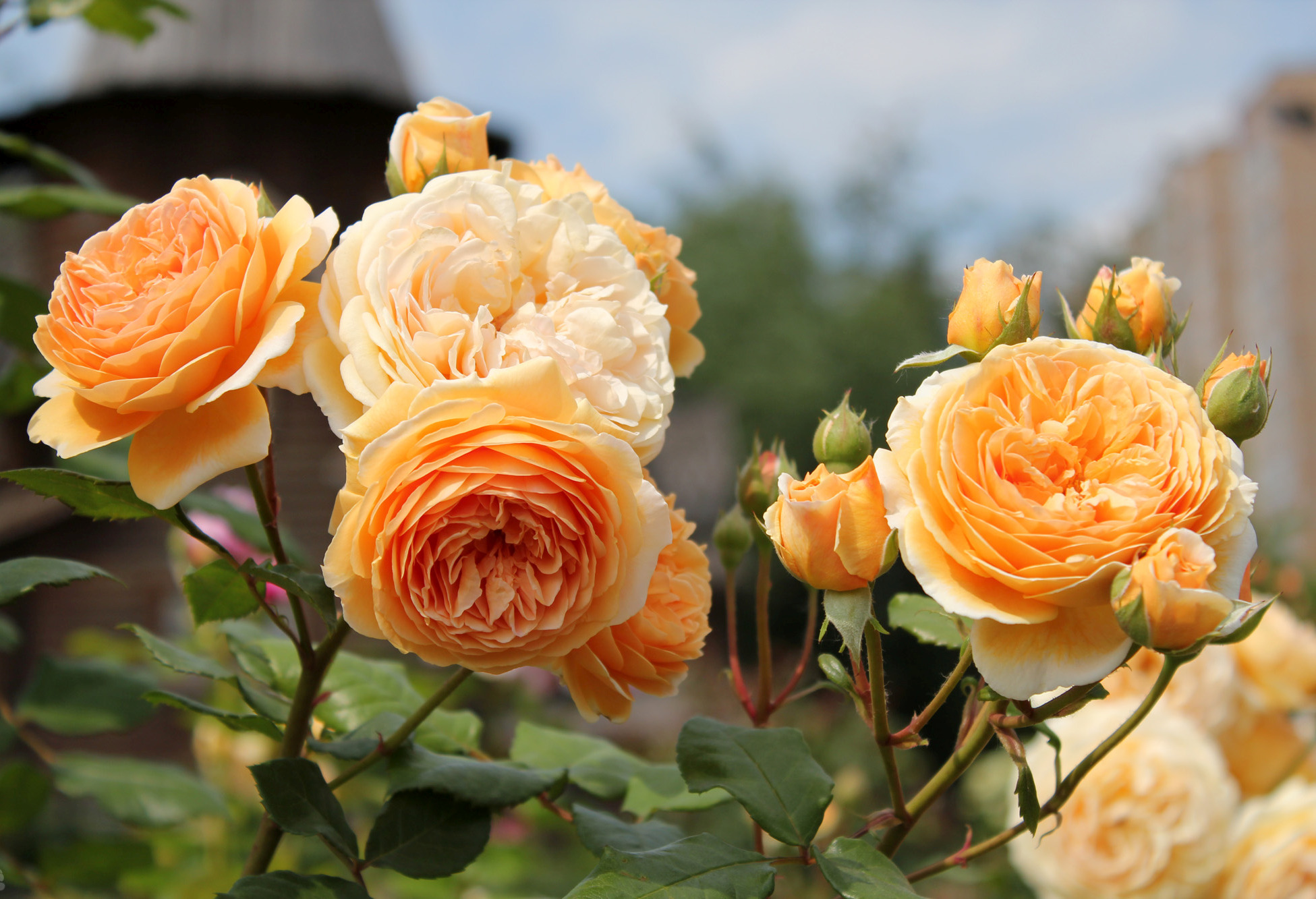It is difficult to find a person who would not like roses. After all, these flowers can be called royal. Roses are the perfect decoration for any garden plot. However, such plants require careful and constant care. This is the only way to get beautiful flowers exuding the most delicate aromas.
Roses are moody plants. Therefore, it is worth treating them with caution. You need to start caring for these plants immediately after the end of winter. What is it all about?
Content
The main stages of care
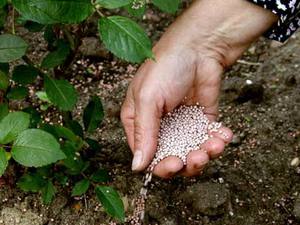 Spring rose care is not that easy. There are several steps by following which you can expect beautiful flowers that are not infested with pests.
Spring rose care is not that easy. There are several steps by following which you can expect beautiful flowers that are not infested with pests.
Processing roses in spring from diseases and pests - the main stage. Do not neglect it.
Of course, the plant should be looked after throughout the year. However, at the end of winter, it is required:
- Carry out competent watering.
- Fertilize correctly.
- Form the crown of the bushes and prune.
- Treat plants from diseases and pests.
Work schedule by month
It is in March that you should start caring for these plants. At this time, they remove the winter shelter from the bushes, install special supports, carry out garters and, of course, hilling.
In April roses must be sprayed for prevention purposes. Otherwise, the plant may get sick. It is worth considering that the soil around the bushes is also subject to processing. During this period, you can also do plant propagation. New roses planted in April will take in better.
In May, another preventive spraying should be carried out. At this time, fertilizing is also applied, and bushes are being trimmed.
In warm latitudes, work should be started at the end of winter. The main thing is that the snow has already melted from the site, and the weather becomes drier and warmer. The primary treatment of roses should be completed before vegetative growth begins.
How roses are covered
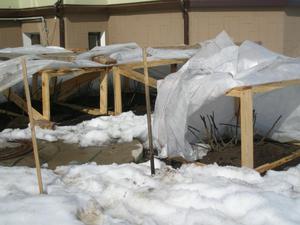 If you live in a cold climate, it is better to cover the rose bushes for the winter. Otherwise, these delicate plants will die from the cold. Roses are usually covered in November, when the air temperature does not rise above -5 ° C.
If you live in a cold climate, it is better to cover the rose bushes for the winter. Otherwise, these delicate plants will die from the cold. Roses are usually covered in November, when the air temperature does not rise above -5 ° C.
If this moment is missed, the roses may die. Temperatures below the specified limit are destructive for them. However, you should not cover the flowers even in warm weather. Roses can rip and die.
After removing dry leaves and wilted inflorescences, the plants are covered with warm material... As a rule, burlap or spunbond is used for this. After that, a construction is made of wire mesh or plastic.
Its walls should be located 25 centimeters from the bush. The structure is filled with fallen leaves or straw. Outside, it is better to wrap it with roofing material. You can also use plastic wrap... The design should be done 10 centimeters above the plant.
How to remove shelter
When spring comes, roses need to be gradually opened.After the snow melts, you should open the ends. Roses should be well ventilated. Otherwise, the plants will start to rot and then rot. At night, the roses should be closed for the first time.
If the temperature is very low, then the plants should be covered during the day. As the temperature rises, the layer of roofing material should be gradually removed.
Straw and fallen leaves do not immediately clean upas the air temperature is low at night. During the day, the branches of plants can burn in the sun. It is best to open the bushes in cloudy and calm weather. If this is not possible, then it is worth creating a shadow.
If the plants were covered with agrofilm, then in the spring this material can not be removed, since it does not accumulate condensation and allows the roses to breathe. In order for the soil around the bushes to warm up faster, the roses need to be piled up and a layer of peat removed from them. However, do not rush to fully open the root collar of the plant.
How to prune
So how to care for roses in spring? According to many, the main pruning of roses should not be done in the fall, but in the spring. This ensures that the plants will thrive in winter.
Exists a few general rules pruning for both decorative and fruit roses. They should be guided during this procedure:
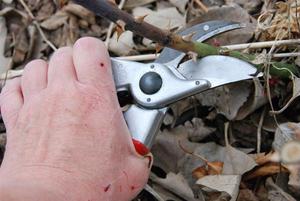 Removing branches that have dried up during the winter. It is also worth removing the damaged areas.
Removing branches that have dried up during the winter. It is also worth removing the damaged areas.- It is necessary to carefully examine the bushes. Look for a few strong branches with healthy buds visible.
- Strong branches should be shortened to the first healthy bud.
- All shoots growing inside the bush, as well as branches that will not grow, should be removed. They will only consume the nutrients of the plant.
- After that, the crown of the rose should be formed. In this case, the center of the plants must be open.
There are several main factors to consider when pruning roses. First of all, the climate is important. In cold regions, plants do not have time to grow much during the summer. In addition, the variety of roses also plays an important role.
For example, it is recommended to shorten spiked varieties by about 10-30 cm, tea, standard and simple ostinka - up to 100 centimeters, in floribundas and tall ostinka - up to 50 cm.
Spring maintenance of roses is very important for the normal growth of these plants. In the process of pruning, you should follow some recommendations. First of all, you should choose a very sharp instrument. The best thing use pruner... So here are some tips:
- branches should be cut a few millimeters above the bud;
- the cut should be made oblique, it should be directed to the same direction as the kidney;
- if, after cutting the shoot, healthy white wood is not visible, then it should be cut again, this must be done until healthy tissue appears;
- the crown of the bush should be finally formed only after the shoots have grown by 5 centimeters;
- if several shoots have grown from one bud, then one should be removed;
- at the end of pruning, all the bushes should be treated with a solution of copper sulfate;
- if frosts are noted at night, then the roses need to be covered with a film.
Installation of supports
Spring care for roses isn't just about pruning. It is important to install the props on time. Experts recommend using permanent and sturdy structures, which allow you to tie roses without much difficulty.
Their safety should be checked every spring. In case of any breakdowns, it is worth repairing them. Otherwise, the damaged support simply will not support the weight of the branches. Use green garden self-locking wire for the tie.
Fertilizing and mulching roses
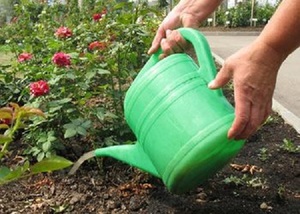 For roses to grow well after winter, you need to feed them. Fertilizers for such plants should contain phosphorus, magnesium, nitrogen and potassium... You can buy such funds at any specialized store.
For roses to grow well after winter, you need to feed them. Fertilizers for such plants should contain phosphorus, magnesium, nitrogen and potassium... You can buy such funds at any specialized store.
This is not particularly difficult.The range of such fertilizers is very large, and if you cannot choose, then you should pay attention to the components.
You can feed plants with such compositions several times throughout the year. In the spring, this should be done during the period when the active growth phase begins. Fertilizers should also be applied in the summer after the first flowering.
Moreover, it is necessary evenly distribute on the surface of the soil 28 grams of the drug. After that, the soil should be cultivated with a hoe.
Fertilizer should only be applied to wet soil. If the soil for any reason remains dry, then it must be moistened. Enough water the soil around the bush. You can leave a hose with a small stream near the rose. After a few hours, the soil will become sufficiently moistened and fertilizer can be applied.
After pruning and fertilization have been carried out, it is necessary to carry out mulching bushes... To do this, evenly distribute garden compost around the roses. A bucket of this composition must be placed under each bush. Top the compost with a layer of sawdust or wood chips.
It should be noted that the material used for mulching roses should not cover the base of the trunk. Otherwise, the access of moisture and heat to the plant roots will be limited.
Correct mulching will ensure the safety minerals, heat and moisture in the soil, and protect the root system. This will significantly improve the appearance of roses.
Pest and disease control
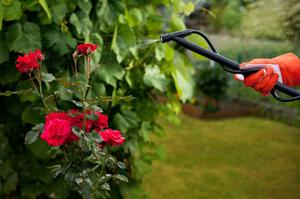 Roses are delicate plants that are often susceptible to all kinds of diseases, as well as insect attacks. Most often, these plants suffer from beetles, aphids, ticks, caterpillars, and so on.
Roses are delicate plants that are often susceptible to all kinds of diseases, as well as insect attacks. Most often, these plants suffer from beetles, aphids, ticks, caterpillars, and so on.
After the first buds begin to bloom, to process plants from pests and diseases. For this, it is better to use special preparations. They can be purchased at specialized stores.
The seller, if necessary, will tell you which drug will help protect roses from this or that misfortune. For processing, a combination of agents such as insecticide and fungicide.
This will significantly save money, as well as protect flowers from black spots, aphids, rust on foliage and powdery mildew. Roses should be processed in dry, calm weather in the evening.
Roses should be sprayed every two weeks from the moment the active growth phase began. Many experts argue that you can do with two treatments. One should be spent in the spring, and the second in the summer after the end of the first flowering.
If you grow thorn roses on your site that bear fruit, then they should not be treated with synthetic pesticides and insecticides. In this case it is better use natural preparations, preferably plant-type fungicides.
Caring for roses after winter is a laborious process that requires patience, as well as certain skills. Despite all the difficulties, many want to grow these plants on their site. After all, such plants are real decorationwhich surrounds itself with a pleasant and delicate aroma.
